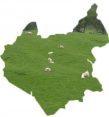Sapcote is in the Blaby district in the south-west of Leicestershire. It is located approximately 5 miles east of Hinckley. In the parliamentary papers of the nineteenth century, it was known as ‘Sapcoate’. As the returns below indicate, in the early 19th century, many villagers were employed in the framework knitting industry.
Daily schools for poorer families in 1818 (population 692 in 1811)
The village contained an endowed school which taught 52 children. The master’s annual pay was £50, which was made up of money from three different sources. One of the sources was the fees paid by 12 of the children’s parents. They were charged 2 guineas per annum, which was £25 4s. in total. The master was presumably given £6 of this amount per annum. The second source was from the rent of 2 acres 2 roods and 31 perches of land. The final source was from a trust paid by the rector of £13 2s. 1d. from the land.
There was also a school which belonged to the established church which had 96 scholars, as well as a Methodist school, for which the number of pupils is not mentioned. Both of these schools were subscription schools. It is not specified whether these met on weekdays and Sundays or just on Sundays.
In addition, the parish had a dame’s school, but nothing more is recorded about this school.
The Minister who signed the return at the time, James Eyre Harington, had observed that ‘the poorer classes are desirous of sending their children to school; but when the stocking trade is flourishing, they keep them at home to assist in the support of their families; but when the contrary, the foundation number of children is always full, which is the case at present’.
Daily schools in 1833 (population 871 in 1831)
The parish had a day and Sunday school which belonged to the established church and was endowed. It taught 47 males and 13 females during the week. The school had a lending library attached to it.
Additionally, the parish contained several small schools where the children mainly took part in seaming stockings made by frame-work knitters.
Daily schools connected to the Anglican Church in 1846-7
The Anglican daily and a Sunday school mentioned above continued. It was united to the National Society and had a total of 80 boys and 51 girls, some of whom were taught in the week-days, others were taught in the Sunday school, while the rest attended the school both on week-days and on Sundays. There were 5 male gratuitous teachers and 4 female teachers. The master was paid £44 14s. in total. The school was said to have had an unsecured schoolroom and needed a school house for the master. It was supported by endowments and payments.
Sunday schools
In 1818
It is likely that the Anglican and Methodist schools mentioned above met on Sundays.
In 1833
The Anglican day school mentioned above had a Sunday school attached, and this was better attended on Sundays, especially by girls, with 48 boys and 45 girls recorded as pupils. The parish also had a Wesleyan Methodist Sunday school with 48 males and 55 females, which was supported by an annual collection.
Anglican Sunday school in 1846-7
See above.
In 1851 (population 724)
On Sunday March 30th 1851, 89 scholars attended the Sunday school for the ancient parish church of All Saints in the morning session, while 94 scholars went to the afternoon Sunday school. It was recorded that the average number of Sunday school scholars in the 12 months before this date was 90 in the morning session and 86 in the afternoon sessions. The rector would give a lecture in the school room every Sunday evening. The Wesleyan Methodist Sunday school had 63 scholars attending in the afternoon that day, and 26 in the evening.
Return to A History of Leicestershire Schools: A-Z
Sources
- Education of the Poor Digest, Parl. Papers 1819 (224)
- Education Enquiry, Parl. Papers 1835 (62)
- National Society for Promoting the Education of the Poor in the Principles of the Established Church, Result of the Returns to the General Inquiry made by the National Society, into the state and progress of schools for the education of the poor … during the years 1846-7, throughout England and Wales ( London, 1849).
- 1851 Ecclesiastical census
